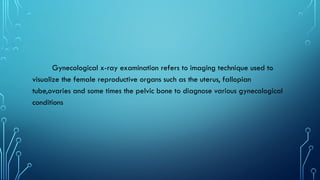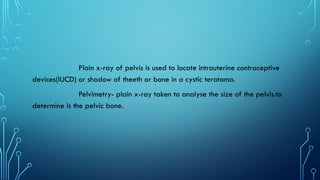Xray and usg Powerpoint presentation By Shanu
- 2. X-RAY EXAMINATION X-ray examination (radiography) are one of the most common and versatile imaging tools used in medicine,is a diagnostic imaging technique that uses electromagnetic radiation to create image of the internal structures of the body especially bones and some of soft tissues
- 3. Gynecological x-ray examination refers to imaging technique used to visualize the female reproductive organs such as the uterus, fallopian tube,ovaries and some times the pelvic bone to diagnose various gynecological conditions
- 4. Plain x-ray of pelvis is used to locate intrauterine contraceptive devices(IUCD) or shadow of theeth or bone in a cystic teratoma. Pelvimetry- plain x-ray taken to analyse the size of the pelvis.to determine is the pelvic bone.
- 5. Special x-rays are used for gynecological patients are Hysterosalpingography Lymphangiography
- 6. HYSTEROSALPINGOGRAPHY Hysterosalpingography is a specialized xray procedure used to examine uterus and fallopian tube. It is commonly used in the evaluation of infertility and to note tubal patency
- 7. LYMPHAGIOGRAPHY Pelvic lymphagiography is a diagnostic imaging procedure used to visualize the lymphatic system in the pelvic region and to locate the lymph glands involved in pelvic malignancy
- 8. INDICATIONS Detection and staging of pelvic cancer ( cervical and ovarian cancers) Evaluation of lymph node metastasis Assessment of lymphatic leakages, obstruction or malformations Diagnosis of lymphedema
- 9. CONTRA-INDICATIONS Absolute contraindications • Known hypersensitivity to contrast dye • Severe Renal impairment •Severe Congestive Heart failure Relative Contraindications •Active infection at the injection site •Pregnancy •Coagulation disorder or on an anticoagulation therapy •Thyroid Disorder (Hyperthyroidism)
- 10. PROCEDURE #Patinet preparation •fasting be required •Allergy to contrast dye should be ruled out •Informed consent should be obtained #Injection site Usually performed via pedal lymphagiography, injecting contrast dye into the lymph vessels of the foot or via internodal approach(inguinal lymph) #Imaging Technique Series of x-rays,are taken as the contrast travel through lymphatic vessels.
- 11. FINDINGS MAY REVEAL #Enlarged or obstructed lymph nodes #Leaking lymphatic vessels # Lymphangiomas #Malignant infiltration of lymph nodes
- 12. AFTER CARE • observation for allergic reaction • Hydration to flush out contrast • Rest and monitoring of injection site
- 13. RISK AND COMPLICATIONS • Allergic Reaction • Infection and inflammation of injection site • Lymphatic vessel rupture or embolism • Temporary swelling or pain
- 15. INTRODUCTION Gynecological ultrasonography refers to the application of medical ultrasonography to the female pelvic organs especially the uterus, fallopian tube as well as the bladder,the rectouterine pouch.The test is often reffered to simply as an ultrasound or as a sonogram
- 16. HOW IS ULTRASONOGRAPHY PERFORMED Sonography uses a device called a transducer to send out ultrasound waves at a frequency too high to be heard.This transducer is placed on the skin and the ultrasound waves moves through the body to the organs and structures and an echo returns to the transducer.The transducer process the reflected waves,which are then converted by a computer into am image of the organs or tissues being examined. An ultrasound gel is placed on the transducer and on the skin to allow for smooth movement of the transducer over the skin and to eliminate air between the skin and the transducer for the best sound conduction.
- 17. TYPES OF USG • #Transvaginal/Pelvic ultrasound (trough the vagina) • #Transabdominal (through the abdomen) • #Doppler ultrasound
- 18. TRANSVAGINAL/PELVIC ULTRASOUND A long transducer is covered with a plastic or latex sheath and lubricated with the conducting gel,is inserted in the vagina. The transducer will be gently turned and angled to bring to focus the areas for study
- 21. REASONS FOR PELVIC ULTRASOUND Pelvic ultrasound maybe used for measurement and evaluation of the female pelvic organ and include: #Size,Shape and position of the uterus and ovaries #Thickness the ecogenicity(darkness or lightness of the image related to the density of the tissue) and presence of Fluid or masses in the endometrium,myometrium, fallopian tube or in or near the bladder #Length and thickness of the cervix #Change in bladder shape #Blood flow through the pelvic organs
- 22. #Abnormalities in the anatomic structure of the uterus #Fibroids,tumours,masses, cyst and other type of tumors within the pelvis #Presence and position of an intrauterine contraceptive device #Pelvic inflammatory diseases #Postmenopausal bleeding #Monitoring of ovarian follicle size for infertility evaluation
- 23. #Aspiration of follicles,fluid and egg from ovarian for invitro fertilization #Ectopic Pregnancy #It may also be used to assist with the procedure such as endometrial biopsy
- 24. RISK OF PELVIC ULTRASOUND # There is no radiation used and generally no discomfort from the application of ultrasound transducer to skin during trans abdominal ultrasound.Slight discomfort with the insertion of Transvaginaltransducer into the vagina. # Some women may have allergic reaction to the plastic or latex sheath used as covering for the ultrasound transducer. # During a transbdominal ultrasound some women experience discomfort from having a full bladder while lying on the examination table
- 25. # Severe obesity #Barium within the intestine from a recent barium procedure # Intestinal gas
- 26. PROCEDURE OF PELVIC ULTRASOUND #For vaginal ultrasound examination bladder needs to be emptied before the procedure. # Instruct patient to remove any clothing or jewellery or other object that may interfere with the scan. # Change patient to hospital gown. # Help patient to lie on the examination table with feet and legs positioned as for the pelvic examination (lithotomy position)
- 27. • # The physician will introduced the transversional transducer covered with a plastic sheath and lubricated. • # The transducer will gently turned and angled to bring to focus the area of study • # Images of organs and structures will be displayed on the computer screen, images maybe recorded on various media for healthcare record. • # Ones the procedure has been completed the transducer will be removed. • # Assistant patient to get down from the examination table and instruct to change to her own clothes
- 28. TRANSBDOMINAL ULTRASOUND The transducer is placed on the abdomen using the conductive gel it is commonly performed for both diagnostic and monitoring purpose.
- 30. INDICATIONS Pregnancy scan Abdominal pain Pelvic organ assessment Liver, gallbladder,kidney, pancreas evaluation Masses or Cysts Ascites detection
- 31. LIMITATIONS • Less clear in obese patient. • Limited views in patient with bowel gas. • Not suitable for detailed imaging or detailed structures.
- 32. ADVANTAGES • Non-invasive • Painless • Real-time imaging • Safe in pregnancy
- 33. PROCEDURE # Preparation of patient • Generally no fasting or sedition is required for abdominal ultrasound. • Drink a minimum of 750 ml of clear Fluid at least one hour before procedure.Do not empty the bladder until after the examination. #Explain to the patient • To remove any clothing jewellery or other object that my interfere with the scan and wear hospital gown. • To lie on her back on examination table.
- 34. • # Apply ultrasound gel on abdomen. • # Press transducer against the skin and move around over the area to be studied. • # If blood flow is being assessed a ‘whool’ sound will be heard. • # Images will be displayed on the computer screen and recorder on various media for health record. • #once the procedure is completed,the gel on abdomen will be removed. • #Patient will be asked to empty her bladder.
- 35. DOPPLER ULTRASOUND This is used on the abdomen to show the speed and direction of the blood flow in certain pelvic organ. Ulike a standard ultrasound,some sound waves during The Doppler examination are audible.This is used in obstetrics to assess placental blood flow and fetal heart rate.
- 36. PURPOSE OF DOPPLER ULTRASOUND • # Detect blocked or narrowed blood vessel. • # Check for poor circulation • # Monitor blood flow • # Evaluate fetal blood flow in pregnancy • # Diagnosis of DVT, assess arterial occulusion or stenosis
- 37. PROCEDURE • # A water-based gel is applied to the skin. • # A transducer is moved over the area. • # Sound waves bounce of blood cells and creates images. • # Non invasive and Painless
- 38. PREPARATION • # Usually no special preparation is required. • # For abdominal doppler,fasting maybe required 6 to 8 hours • # Loose clothing is recommended
- 39. AFTERCARE • No specific care is required patient can resume to normal activities immediately.
- 40. DOPPLER ULTRASOUND IN PREGNANCY INDICATIONS # Intrauterine Growth Restriction[IUGR] # Multiple pregnancy # Previous pregnancy complications # Suspected fetal distress # Asses blood flow between the mother,placenta and fetus
- 41. WHAT IT SHOWS • # Whether the fetus is getting enough Oxygen and nutrients. • # Risk of preterm birth or stillbirth • # Helps guide decisions on timing of delivery







































![DOPPLER ULTRASOUND IN PREGNANCY
INDICATIONS
# Intrauterine Growth Restriction[IUGR]
# Multiple pregnancy
# Previous pregnancy complications
# Suspected fetal distress
# Asses blood flow between the mother,placenta and fetus](https://image.slidesharecdn.com/x-rayandusg-250809031135-95c01587/85/Xray-and-usg-Powerpoint-presentation-By-Shanu-40-320.jpg)
